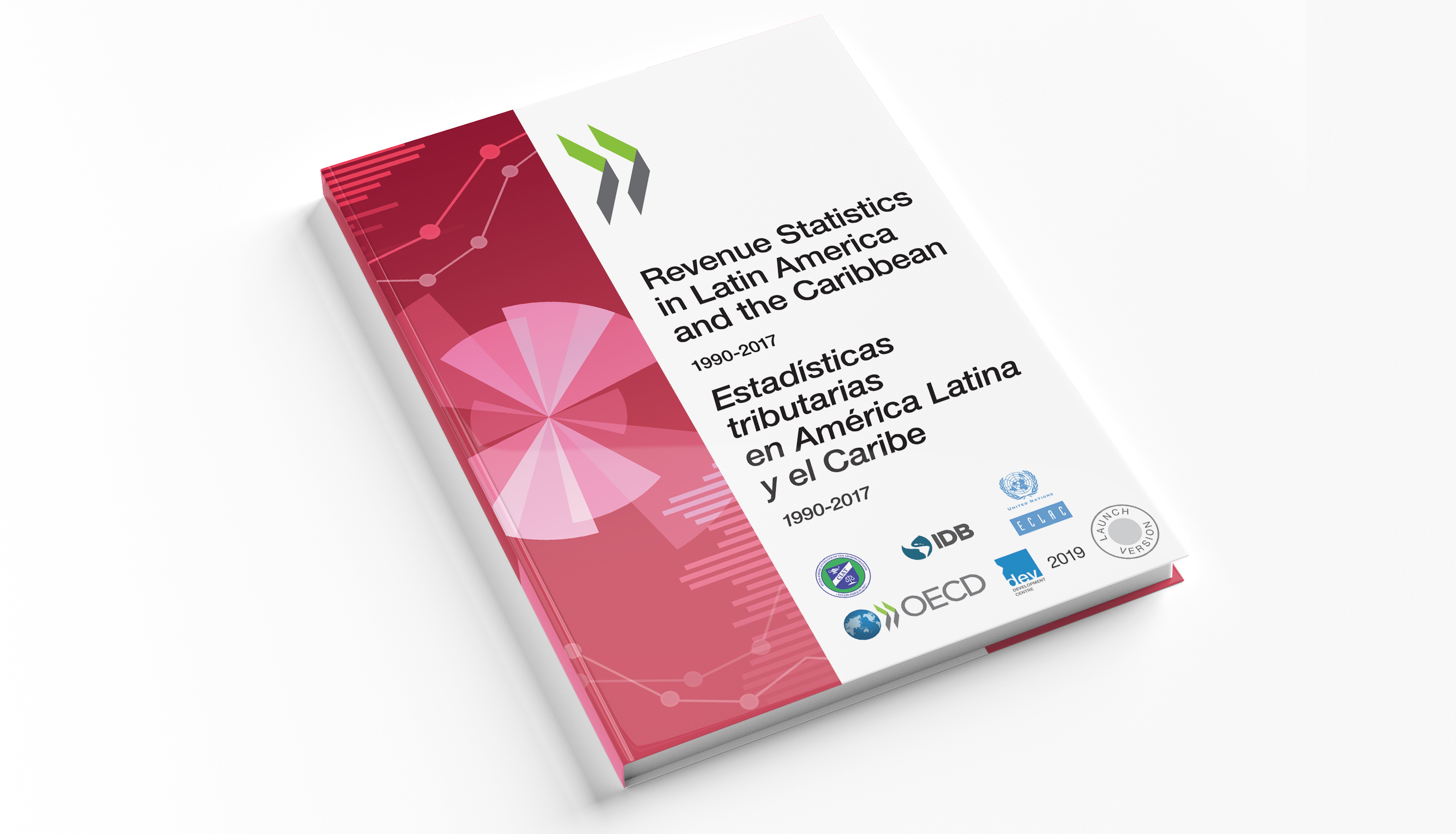Latin America and the Caribbean: Public revenues rebound in 2017 after dip in 2016
Work area(s)
Report "Revenue Statistics in Latin America and the Caribbean 2019" was launched today at ECLAC during the XXXI Regional Seminar on Fiscal Policy.

The average tax-to-GDP ratio in Latin America and the Caribbean (LAC) rose to 22.8% in 2017, a gain of 0.2 percentage points from 2016, according to Revenue Statistics in Latin America and the Caribbean 2019. The report, launched today at the XXXI Regional Seminar on Fiscal Policy in Santiago, Chile, finds that the rebound was primarily driven by Caribbean countries and in particular Guyana and Barbados, on the back of tax policy and administration reforms. The LAC average remained 11.4 percentage points below the average of OECD member countries (34.2% of GDP in 2017) but the difference between the two regions has declined from 16.4 percentage points in 1990.
Revenue Statistics in Latin America and the Caribbean is a joint publication by the Inter-American Centre of Tax Administrations (CIAT), the Economic Commission for Latin America and the Caribbean (ECLAC), the Inter-American Development Bank (IDB), the Organisation for Economic Co-operation and Development (OECD) Centre for Tax Policy and Administration and the OECD Development Centre. This is the eighth edition and the first produced through the European Union’s Regional Facility for Development in Transition for Latin America and the Caribbean. This year’s edition covers 25 countries, although only partial data are available for Venezuela.
The increase in the unweighted average tax-to-GDP ratio in the LAC region in 2017 reversed a year-on-year decline of 0.1 percent points in 2016 and reflected an overall recovery in the regional economy. However, the year-on-year change was uneven across the region: while tax revenues increased as a proportion of GDP in 12 countries, they declined in 10 and remained unchanged in two. Moreover, tax-to-GDP ratios across the LAC region vary significantly, ranging from 12.4% in Guatemala to 40.6% in Cuba.
The LAC region continues to rely on taxes on goods and services, with value-added taxes alone accounting for 27.9% of total tax revenues on average in 2017, equivalent to 6.0% of GDP. Over the past decade, corporate income tax (CIT) revenues have declined as a percentage of GDP whereas revenues from personal income tax (PIT) have steadily increased, respectively reaching 3.4% and 2.2% of GDP on average in 2017. However, while CIT revenues remain higher than the OECD average (2.9% of GDP), PIT revenues are still well below the OECD average (8.2% of GDP). Overall, the average tax structure in LAC has evolved to be closer to the average OECD structure, thanks to an increase in revenues from income taxes and value-added tax (VAT) and a decline in revenues from taxes on trade.
Environmentally related taxes are an emerging source of revenues in a number of LAC countries. Across the 22 countries for which data are available, revenues from this source averaged 1.1% of GDP, versus an OECD average of 1.6%. In recent years, Chile, Mexico and Colombia have introduced significant green tax reforms.
A special feature for the 2019 edition highlights differing trends in hydrocarbons and mining fiscal revenues in 2017. Hydrocarbon revenues stabilised during the year, at their 2016 level of 2.3% of GDP, after falling sharply between 2014 and 2016. Mining revenues rose from 0.3% of GDP in 2016 to 0.4% in 2017 as CIT receipts surged. Fiscal revenues from non-renewable natural resources, both from hydrocarbons and mining, are estimated to have grown in 2018 as international prices remained strong in the first half of the year; a substantial price correction in the second half of the year put into question the sustainability of this recovery.
A second special feature highlights that property tax levels are low relative to OECD countries and are not at the level required to help local governments meet the challenges of increasing decentralisation, extensive urbanisation and growth in informal settlements.
Key findings
- Tax levels:
- Between 2016 and 2017, the average tax-to-GDP ratio in the LAC region increased by 0.2 percentage points to 22.8%. The average tax-to-GDP ratio also increased by 0.2 percentage points in the OECD area over the same period, to 34.2% of GDP.
- In 2017, the tax-to-GDP ratios of 24 countries covered by the report ranged from 12.4% in Guatemala to 40.6% in Cuba. Brazil and Barbados had the highest tax-to-GDP ratios after Cuba, at 32.3% and 31.8% respectively, while Paraguay (13.8%) and Dominican Republic (13.9%) had the lowest tax-to-GDP ratios after Guatemala.
- In 2017, tax revenues as a percentage of GDP increased in 12 of the countries in the report, declined in 10 and were stable in two.
- Average tax-to-GDP ratios vary significantly across the LAC sub-regions: in 2017, the average for the Caribbean region exceeded the LAC average while the average for South America was in line with the LAC average and the tax-to-GDP ratio of Central America (including Mexico) trailed the regional average.
- Tax structures:
- At 27.9% of total tax revenues, VAT was the largest source of revenue on average in the LAC region in 2017, followed by revenues from taxes on income and profits (27.1%) and from other taxes on goods and services (21.8%).
- Between 1990 and 2017, revenue from VAT as a percentage of GDP more than doubled for LAC countries on average, from 2.3% of GDP in 1990 to 6.0% in 2017.
- The share of revenues from taxes on incomes and profits grew by 6.9 percentage points (from 20.1% to 27.1% of total tax revenues) between 1990 and 2017.
- In the 22 LAC countries for which data are available, environmentally related tax revenues amounted to 1.1% of GDP on average in 2017, versus an OECD average of 1.6% of GDP (2016 figure).
Special feature: Non-renewable natural resource revenues
-
- Hydrocarbon-related revenues in eight oil-exporting countries remained steady as a percentage of GDP in 2017, at 2.3% of GDP, with an increase in non-tax revenues in the sector offsetting a slight decline in tax revenues.
- Revenues from mining in the region rebounded in 2017, rising to 0.37% of GDP on average from 0.28% of GDP in 2016 across the nine countries analysed.
- Revenues from hydrocarbons and mining are estimated to have increased in 2018 despite a sharp correction in prices over the second half of the year.
Special feature: recurrent taxes on immovable property in Latin America:
-
- Revenues generated by recurrent taxes on immovable property in Latin America are a critical mechanism for the provision of basic services but are low relative to OECD countries and not achieving the level required to help local governments meet the challenges of an increasing decentralization of public expenditure, extensive urbanisation and growth in informal settlements.
- As a percentage of GDP, these revenues varied significantly between countries in 2016 – from 0.1% of GDP in Ecuador and 0.2% in Mexico and Peru to 0.8% of GDP in Colombia and 0.9% in Uruguay in 2016. On average across the region, revenues on recurrent taxes on immovable property were equivalent to around 0.3% of GDP, versus an OECD average of 1.1% of GDP.
Press contacts
- CIAT: Publication and Communication Coordination, Neila Jaén (njaen@ciat.org; T: +507 307 2428)
- ECLAC: Public Information Unit (prensa@cepal.org; T:+56 2 2210 2040)
- IDB: Knowledge, Innovation and Communication Sector, Mildred Rivera (mildredr@iadb.org; T: +1 202 623 2319)
- OECD:
- In Santiago: Sebastian Nieto-Parra: +33 646 450 900.
- In Paris: Centre for Tax Policy and Administration ( Hazel.Healy@oecd.org; Tel.: +33 145 24 82 40); OECD Development Centre (Bochra.Kriout@oecd.org; Tel.: +33 1 45 24 82 96)
Related content

XXXI Seminario Regional de Política Fiscal
El XXXI Seminario Regional de Política Fiscal es organizado por la Secretaría Ejecutiva de la Comisión Económica para América Latina y el Caribe (CEPAL), a través de la División de Desarrollo…

Transition toward Sustainable and Inclusive Growth Will Require Changes in Latin America and the Caribbean’s Fiscal Policy
Ministers and authorities from 10 countries in the region are meeting at ECLAC to dialogue about how to expand fiscal space and bolster financing of the 2030 Agenda.
Country(ies)
- Latin America and the Caribbean
Contact
Public Information Unit
- prensa@cepal.org
- (56 2) 2210 2040